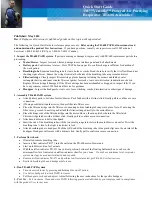
5188235-YIM-B-1016
Johnson Controls Unitary Products
43
Blower Rotation
Check for proper supply air blower rotation. If the blower is
rotating backwards, the line voltage at the unit point of power
connection is misphased (See ‘PHASING’).
Belt Tension
The tension on the belt should be adjusted as shown in Figure 20.
Figure 22: Belt Adjustment
CFM Static Pressure and Power-Altitude and Temperature
Corrections
The information below should be used to assist in application of
product when being applied at altitudes at or exceeding 1000
feet above sea level.
The air flow rates listed in the standard blower performance
tables are based on standard air at sea level. As the altitude or
temperature increases, the density of air decreases. In order to
use the indoor blower tables for high altitude applications,
certain corrections are necessary.
A centrifugal fan is a “constant volume” device. This means
that, if the rpm remains constant, the CFM delivered is the
same regardless of the density of the air. However, since the air
at high altitude is less dense, less static pressure will be
generated and less power will be required than a similar
application at sea level. Air density correction factors are shown
in Table 14 and Figure 23.
When installing equipment in a facility with a 3 phase
high-leg delta power supply, care must be taken to
ensure that the high-leg conductor is not attached to
either of the two legs of the (single phase, direct drive)
X13 or ECM motors. Failure to do so can result in the
motor acting erratically or not running at all.
Check for the high leg conductor by checking voltage of
each phase to ground.
Example: A or L1 phase to ground, voltage reading is
120V. B or L2 phase to ground, voltage reading is 195 to
208V. C or L3 phase to ground, voltage reading is 120V.
Therefore B or L2 phase is the high Leg. The high
should always be wired to the center or B or L2 tap.
Note:
Check all three phase motors and compressors
for proper rotation after making a change. If it is
necessary to change 3 phase motor rotation, swap A or
L1 and C or L3 only.
*Never Loosen
(A)
(C)*
(B)
Span Length
Defl Force
Procedure for adjusting belt tension:
1. Loosen six nuts (top and bottom) A.
2. Adjust by turning (B).
3. Never loosen nuts (C).
4. Use belt tension checker to apply a perpendicular
force to one belt at the midpoint of the span as shown.
Deflection distance of 4mm (5/32”) is obtained.
To determine the deflection distance from normal position,
use a straight edge from sheave to sheave as reference
line. The recommended deflection force is as follows:
Tension new belts at the max. deflection force
recommended for the belt section. Check the belt
tension at least two times during the first 24 hours of
operation. Any retensioning should fall between the min.
and max. deflection force values.
5. After adjusting re-tighten nuts (A).
Table 14: Altitude/Temperature Correction Factors
Air
Temp.
Altitude (Ft.)
0
1000
2000
3000
4000
5000
6000
7000
8000
9000
10000
40
1.060
1.022
0.986
0.950
0.916
0.882
0.849
0.818
0.788
0.758
0.729
50
1.039
1.002
0.966
0.931
0.898
0.864
0.832
0.802
0.772
0.743
0.715
60
1.019
0.982
0.948
0.913
0.880
0.848
0.816
0.787
0.757
0.729
0.701
70
1.000
0.964
0.930
0.896
0.864
0.832
0.801
0.772
0.743
0.715
0.688
80
0.982
0.947
0.913
0.880
0.848
0.817
0.787
0.758
0.730
0.702
0.676
90
0.964
0.929
0.897
0.864
0.833
0.802
0.772
0.744
0.716
0.689
0.663
100
0.946
0.912
0.880
0.848
0.817
0.787
0.758
0.730
0.703
0.676
0.651
















































